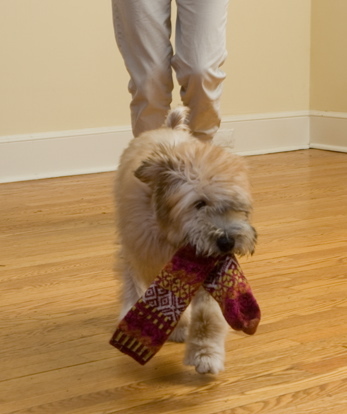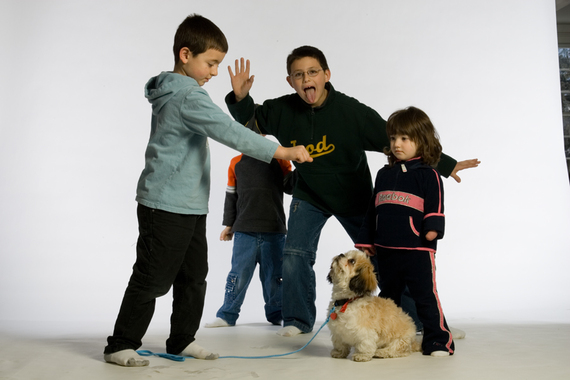The other morning my 3-year-old niece ran into the room screaming, "I did it, I did it! I put my backpack on!" And in fact she had done it... a true achievement. Mind you, it was on upside down with the zipper facing the floor, but that wasn't the point -- the point was that she had done it herself, and for that I congratulated her. At this point she went off to show everyone else in the household, and for a moment I held my breath... would anyone mention that she had put it on wrong, thus halting the track of her enthusiasm and, in a sense, "destroying" her achievement? Alas, no one did, and the moment at least for me will be frozen in time.
As is my particular habit, I filtered the experience through my dog lens, and an appointment later in the week gave me an opportune moment to sharpen my analogy. A few weeks back I wrote the first of a three-part series on Top-Rated Training Tips. Let this piece stand in as part two. Come, meet Max.
Max, an adorable 18-week-old Labradoodle puppy, had, according to his mother, confused the word "NO" with his name, and as such, she was at her wits' end informing me: "Between grabbing toys, chasing the children, nipping us, all I say is 'No, no, no!' But the more I say it, the worse he gets!" Frustrated and exhausted, this particular mother handed me the leash and, in essence, gave me the liberty to train her dog!
Little did she know that I would be training her, too.
Max was like all other puppies his age. Clever, self-possessed and enthusiastic. He was excited by new discoveries and driven to repeat whatever brought him satisfaction or attention.
Like children, he didn't care if the attention was negative or positive. Since a yelling person sounds like a barking dog, it egged him on. Being chased, though it may scare some dogs into submission, is a favorite canine pastime -- guaranteeing a repeat performance.
I suggested a more positive approach. Sliding off his prong collar (which is very dangerous to leave on when a dog is unattended), I fitted him for a conditioning harness. I scooped out a handful of treats, and viola, just like that, he began to relax and focus. I had his attention.
Once a dog or puppy notices they will be rewarded for good behavior, they pay attention. Max turned out to be a people-pleaser. He was both affectionate and needy -- hence the dramatic mania -- and he required only a few repetitions of a certain direction to catch on.
When I dropped a tissue, it took two shakes of the treat cup to instigate a quick trade. After replacing his neck restraint with the harness, Max quickly learned to jog at my side and sit when I asked him -- the vision of which, to his mother, was all the more aggravating: "What gives?" she asked.
What gives was simple to see and easier to explain. As a dog parent she could either build Max up or destroy him.
Imagine a puppy eager to explore, curious and fascinated with the objects and people in his world. When said puppy finds a tissue, (which he doesn't realize is a material object bought with another form of paper) he picks it up -- with his mouth, because he's a dog. Proud and excited, this puppy looks to his person for affirmation. At this point the person has two choices: to build the relationship and trust by congratulating the puppy and refocusing him on a more appropriate object or to destroy their connection by yelling and chasing him, thus completely confusing the dog and, in essence, creating a madness that, once conditioned, is hard to undo. The same can be said for a puppy wandering into a garden or chasing the children -- while the long-term goal is to extinguish the behavior, the first step is to rethink and redirect.
Case and point: Max's kids were six and nine years of age. What his mom labeled as dominant behavior was anything but. A quick observation of his behavior told me all I needed to know.
Oh, did I mention that the kids were boys? The kind who involve their new puppy in wrestling matches until he nips too hard and who show their affection through hugging and head-on nose kisses?
Max's behavior and posture showed reactivity not excitement.
Dogs -- in fact all other mammals save primates -- do not "hug" face-to-face. From Max's perspective, the boys were acting more like rabid puppies or prey animals than humans. This left him on the defensive and in a constant state of alert.
Some kid training was in order, too. Lucky me -- I like training kids as much as I do dogs. I taught the boys some cool games to play with Max -- outdoor fun and indoor activities as well. Their favorite? "Sketch it," where we taught Max to draw on their iPad with his nose.
Next, we gradually deconditioned Max, a fancy word for "helped him get used to," the sounds and motions of kids at play. Max learned to "stay" while the kids ran and rode their bikes. How'd he learn so quickly? First we removed the neck restraint, which had only served to increase his agitation when he was over-stimulated. Next we introduced my Pez Dispenser technique for introducing "stay" around distractions. Holding a fist full of favorite treats (he actually loved shredded bits of turkey cold cuts), Max was repetitively rewarded as long as he could hold still. Initially we began feeding him at a one-to-three-second ratio, then slowly varying the pause between each reward.
I do hope I've offered you a new way to consider puppy behavior. Dogs are a lot like kids who sometimes get it right, sometimes wrong, but who are always looking for a new way to get involved. Good puppy training involves a healthy dose of creative thinking, lots of food and toys to reinforce good choices, and detective-like investigation skills if you've got a behavior you can't seem to redirect. And remember, help is just a phone call away; there are good trainers worldwide whose job and passion is to help dogs and people get along.

